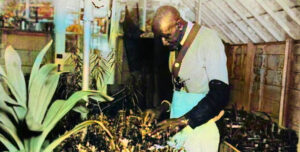20 George Washington Carver
George Washington Carver |
 |
Time period:Born 1864 Died January 5, 1943, age of 78-79 Known as the “Peanut Wizard” Re-introduced crop rotations to American farming Subject:Agriculture |
|
Biography:Born a slave in the early 1860s, George Washington Carver faced a challenging start in Diamond, Missouri. Despite his circumstances, he gained freedom after the Civil War (Goles, 2023). Carver’s insatiable curiosity and determination led him to pursue education, eventually earning a degree in agricultural science. His journey took him to Iowa State University, becoming the first African American to attend and teach there. Carver’s brilliance extended beyond academia; he developed innovative farming techniques, invented numerous products from peanuts and sweet potatoes, and became an influential figure in advancing agricultural science and promoting sustainable practices. His life remains a testament to resilience and intellectual prowess (Demby, 2014). |
|
Summary of their contributions:Carver, hailed as the “Peanut Wizard,” revolutionized agriculture during a challenging era. The boll weevil and mono-cropping of cotton depleted soil, threatening livelihoods. Carver “freed the south from its dependence on cotton by developing hundreds of uses for peanuts and sweet potatoes” (Mackintosh, 1977). Products include a peanut-based milk substitute, peanut oil, peanut candies, soapmaking, flour, soups, salad dressing, muffins, cattle feed, livestock feed, ice cream, and griddlecakes. Most importantly, Carver advocated for the legume’s ability to fix nitrogen in soil, which was desperately needed in the post-monocropping era of cotton (Missouri Department of Agriculture, n.d.). His insights helped struggling farmers and reshaped agricultural practices. |
|
Integration with the BC Secondary Science Curriculum:Carver’s advocacy for legumes, their ability to fix nitrogen, and crop rotations parallel Indigenous farming values. For thousands of years, the Indigenous people of North America prioritized ecological harmony and sustainable practices using crop rotations. Carver’s methods align with diverse crop cultivation, enhancing resilience and mirroring indigenous wisdom in coexisting with nature. Carver’s contributions extend beyond science, embodying a holistic approach to agriculture that echoes indigenous philosophies. |
|
References:Chesapeake Bay Foundation. (2021). What We Owe to George Washington Carver [Photograph]. Rob Schnabel. https://www.cbf.org/blogs/save-the-bay/2021/02/what-we-owe-to-george-washington-carver.html Demby, G. (2014, February 11). George Washington Carver, The Black History Monthiest Of Them All. NPR. https://www.npr.org/sections/codeswitch/2014/02/11/275330069/george-washington-carver-the-black-history-monthiest-of-them-all Goles, K. (2023, February 14). Peanuts, Potatoes, Patents, and Plants – The Life and Times of George Washington Carver. Library of Congress Blogs. https://blogs.loc.gov/law/2023/02/peanuts-potatoes-patents-and-plants-the-life-and-times-of-george-washington-carver/ Mackintosh, B. (1977, August). George Washington Carver and the Peanut. American Heritage, 28(5). https://www.americanheritage.com/george-washington-carver-and-peanut Missouri Department of Agriculture. (n.d.). George Washington Carver: History of an Educator, Innovator, Leader. https://agriculture.mo.gov/gwc.php |
|

